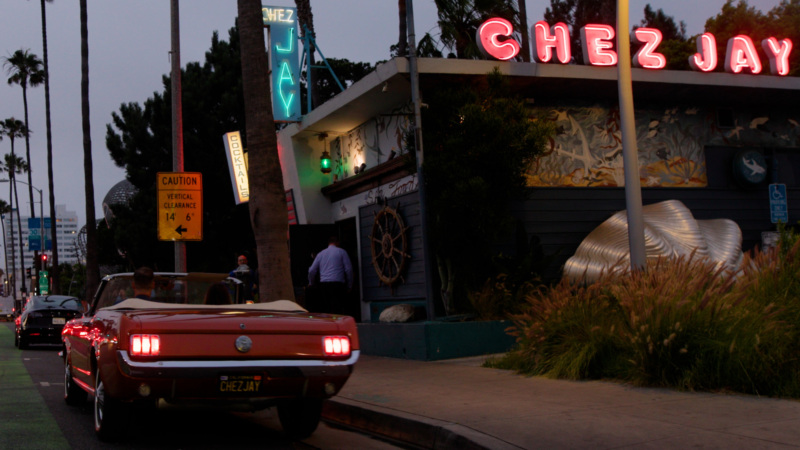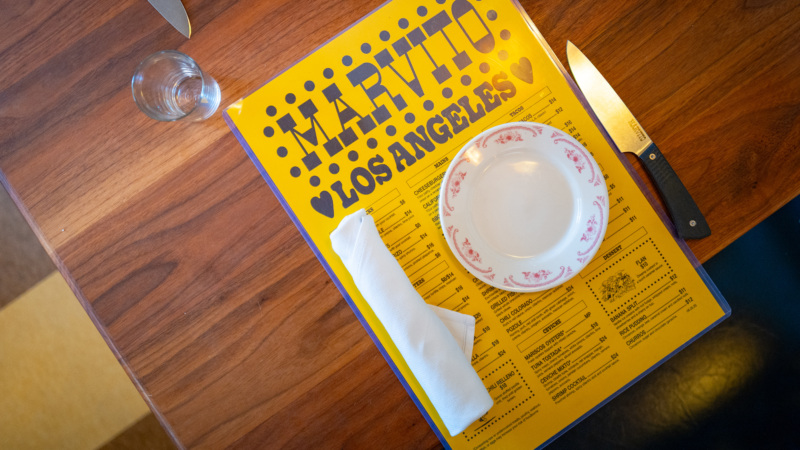
Six Essential Dishes at Holbox, L.A.’s Game-Changing Mexican Seafood Stall
Published:
Holbox is a modestly sized Mexican seafood counter inside Mercado La Paloma, a food court and community hub in South L.A. It’s also the Los Angeles dining experience I most enthusiastically recommend to visitors and locals alike.
My standard line is, “If you go to L.A. and don’t visit Holbox — well, that’s on you.” Jonathan Gold was a superfan, too, and Michelin awarded Holbox its first star this year. So, what’s all the hype about?
Holbox is chef Gilberto Cetina’s romanticized vision of the very best seafood experiences you can have along Mexico’s coasts. He takes inspiration from the ceviche he and his cousin made after going diving in Yucatán, the creative tostadas and almejas preparadas at Ensenada’s famed La Guerrerense, and the octopus tacos he learned to cook when he helped his parents open their first restaurant, Chichén Itzá, 23 years ago, right across the way from Holbox in Mercado La Paloma.
Holbox is also Cetina’s tribute to the local seafood of Southern California, and to the hardworking fishermen and divers he so reveres. “I was always looking for the best stuff, and it turns out, the best seafood is usually what’s being sourced closest to you,” Cetina explains. The chef slowly but surely built relationships with local fishermen, which has enabled him to continuously improve his offerings.
“Bailey [Raith] is a legendary local fisherman, but I had never been able to buy fish from him until recently,” says Cetina. “Someone has to introduce you before he’ll sell to you.” Cetina similarly knew Eric Hodge as the guy that was doing ikejime vermillion rockfish and selling it to Providence and n/naka, but he had never responded to the chef’s attempts at outreach. “It wasn’t until another chef introduced us at an event that Eric agreed to sell to me,” Cetina says.
Holbox has similarly been upping its game when it comes to masa. In 2023, former Chichén Itzá employee Fátima Juárez took over Holbox’s masa program, sourcing heirloom Mexican corn varieties and nixtamalizing them in-house for her stunning handmade tortillas and tostadas. (Earlier this year, she opened Komal Molino in a stall across from Holbox — more on that in a minute.)
No matter if you sit down to a $17 lunch special (which gets you ceviche mixto plus two tacos), or the eight-course tasting menu dinners Cetina holds on Thursdays and Fridays, every dish is a showstopper.
Here, Cetina walks us through the unbridled magic of Holbox through the lens of six dishes.


Taco de Pulpo
“The taco de pulpo has been on the menu since day one. It’s an iconic dish from Yucatán, and it’s one of the few recipes we do at Holbox that I learned from my dad. Normally, the octopus is cut into large chunks and mixed into a looser sofrito, but our version is like an octopus Bolognese. We grind the octopus and cook it down, so the umami and richness intensify, and it tightens up and sits like a paste on the tortilla. We top it with a braised-then-fried octopus tentacle, giving a perfect combination of flavors and textures: the crispy tentacle and the soft, warm sofrito that’s spicy, sweet, and earthy.
“The sofrito takes hours to make and starts with deeply caramelized aromatics, layered in with white wine, octopus stock, tomatoes, peppers, roasted habanero, roasted garlic, and minced octopus. As it cooks down, the octopus integrates into the sofrito, becoming one with it. The last ingredients are calamari ink and lime juice. I don’t use hot sauce on the taco de pulpo because the habanero is already in the sofrito — but if you want to, go for the classic habanero or the chile kut, made with charred habaneros. (‘Kut’ is a Mayan word that means ‘charred.’)”


Live Sea Urchin and Scallop Ceviche
“This is one of the dishes that’s been most significant in getting the word out about Holbox, not only with customers, but with organizations like Michelin and James Beard. It’s pretty and very Instagrammable. It’s one of the recipes that best represents taking a beautiful, local ingredient and transforming it into a Mexican dish without doing too much to it, keeping the essence of the dish about the ingredient.
“We take a beautiful sea urchin, crack it open, clean it, and then make a small ceviche with Baja California bay scallops. The sweetness of those specific scallops complements the sea urchin, but they’re also just neutral enough so they don’t overpower it. You can really taste the urchin through the scallops. A little cucumber and avocado purée, and that’s it.”
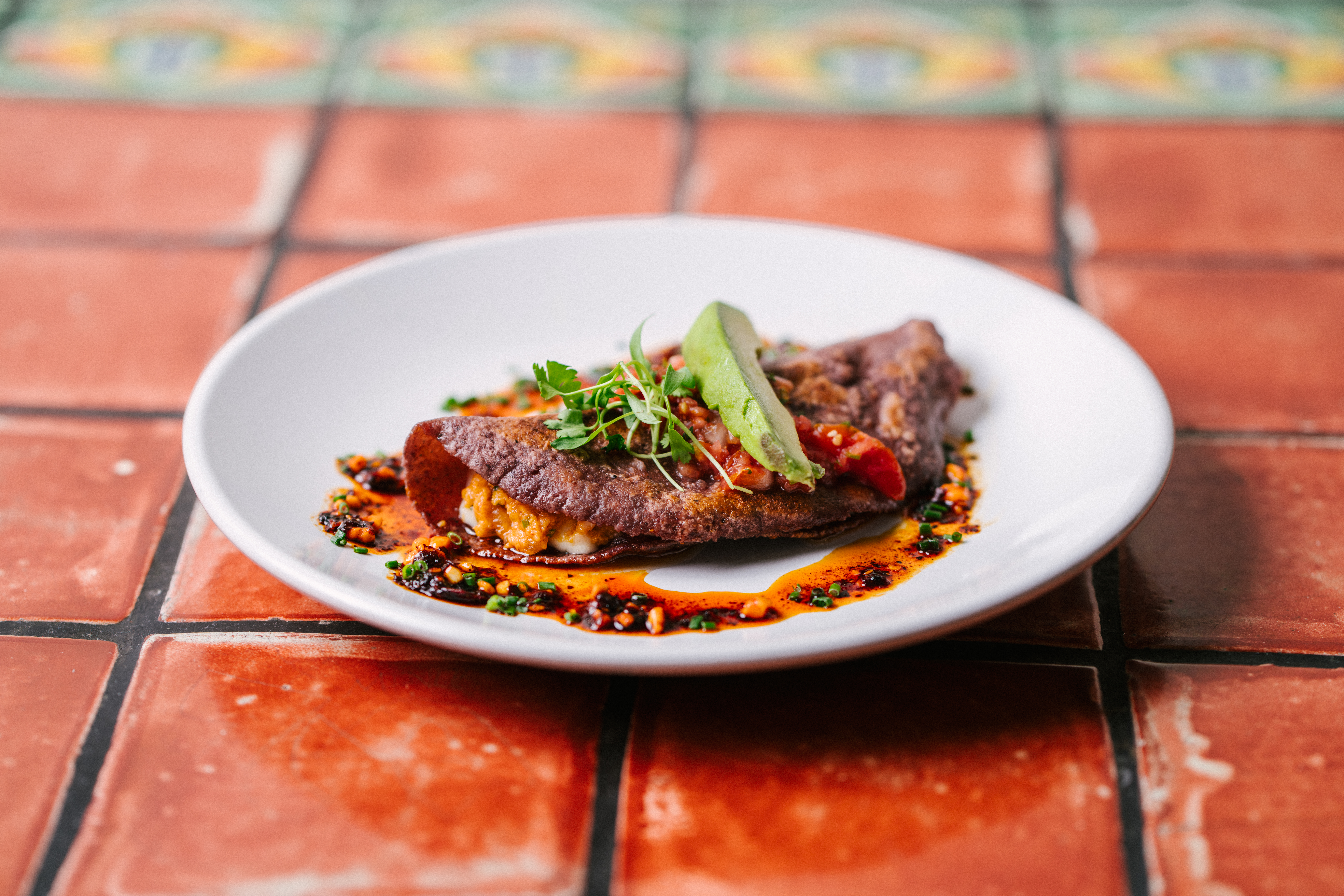
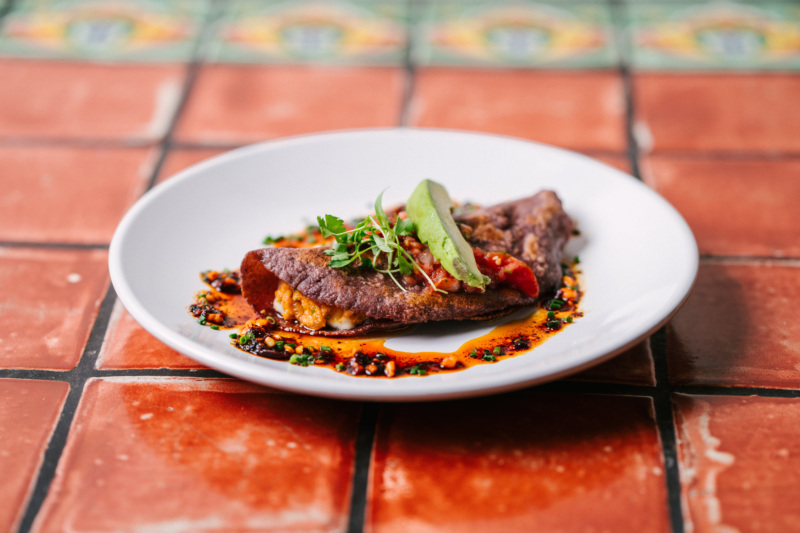
Smoked Kanpachi Taco
“I love this taco so much because it’s such a great use of an underutilized part of the fish. We don’t state it on the menu, but it’s just made with fish heads. After we’ve used our kanpachi filets for ceviche and tacos, we have the frames, or the bones, to use for stocks. The smoked kanpachi, fish sausages, and pâté are all products born out of the need to figure out what to do with that leftover part of the fish. We smoke the heads with applewood in a hot smoker, pick the meat off, and then make a guisado. We stir it with herbs, chiles, and aromatics and cook it down, then it ends up becoming a paste that we can use on tostadas or tacos.
“This dish is based on a smoked marlin taco. So, a classic Northern Mexican Sinaloa preparation. I’ve always loved them, and here in L.A., I love the ones at Coni’Seafood. The idea was: let’s do something like that, but with a fish that’s much more sustainable than marlin. And we ended up using that smoked fish head product. It’s served on a handmade tortilla with locally made quesillo cheese, salsa cruda, avocado, and peanut chile oil.”


Handmade Corn Tortillas
“For the first six years, we were using masa from La Princesita Tortilleria. We decided to have Fátima [Juárez] run our masa program here in 2023. It started how Holbox started: She was passionate about corn like we were passionate about seafood, and there was still a lot to learn. For her, it was about discovering the different corn varieties, their ideal cooking temperatures, soaking times, the right ratios of kal to go in the water with the corn, and what each variety should be used for: tamales, tortillas, pozole, etc. And she’s still learning.
“In the year and a half that Fáti has been sourcing corn from Tamoa, for us and now for Komal, there has to be about 20 varieties of corn that she’s gone through. Tamoa is a really interesting company in that they don’t have this fixed roster of products that you pick from a catalog. They’re constantly sourcing new varieties of corn from small-scale farmers, and it gives us this endlessly rotating list to work from. It became an added layer to what we do at Holbox. Now, we’re not only focused on sourcing interesting and sustainable varieties of fish and crustaceans, but we added this more interesting corn lineup — thanks to the expertise of Fáti — that really is the basis of Mexican food. Slowly, over the years, corn has become more and more of an important component of what differentiates Holbox from other marisquerias.”
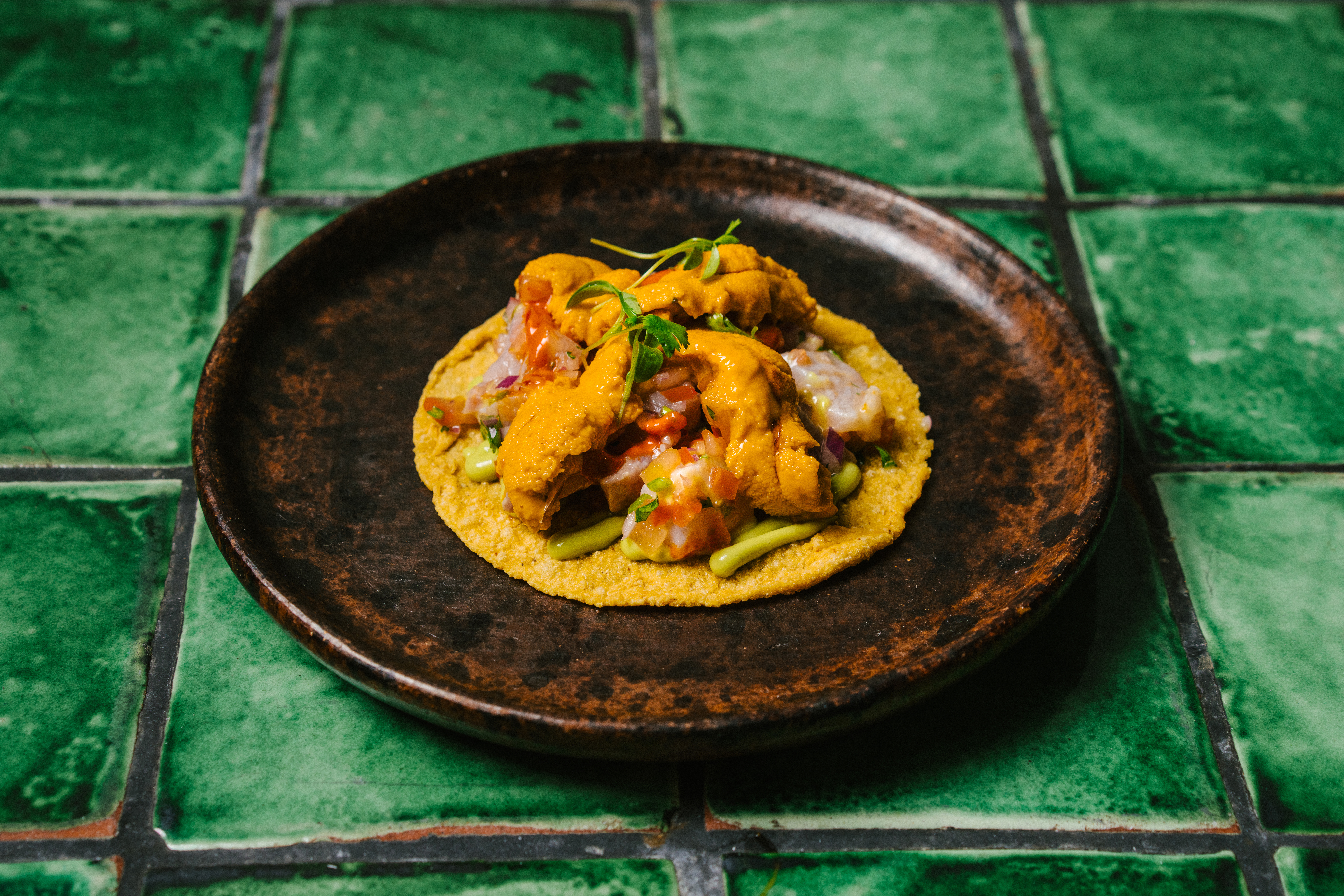

Tostada de Kanpachi and Uni
“We do a few tostadas that aren’t super traditional, like the kanpachi and uni tostada, and the smoked kanpachi tostada. Normally, a tostada is just ceviche, straight up. These two were inspired by seeing places like La Guerrerense in Ensenada do creative takes on mariscos, and trying their fish pâté, almeja, and different combinations of seafood. We wanted a strong ceviche fish base on which to showcase beautiful Santa Barbara sea urchin, and the Omega Blue Baja California kanpachi worked really well for this. It’s a simple tostada: kanpachi ceviche, big pieces of Santa Barbara uni, a little chile de árbol salsa, and we now serve it on our handmade tostadas raspadas — a style that originates from Jalisco, Mexico.”
Tostadas Raspadas
“Everything under the ‘tostadas’ portion of the menu is served on a handmade tostada raspada, but we’ve only been doing the raspadas for a year or so. We take a fresh ball of masa and hand-press it into a tortilla, and we only cook one side, so the top stays raw. Then we put this tortilla on the metate, and with the mano (hand-held grinding stone) of the metate, la respamos, meaning we scrape off the layer of raw masa that was left on the top. That gives us a half tortilla, and it exposes the moist, damp interior. We pop the tortilla in the dehydrator and then fry it, and it gets an almost chicharrón-like puff. The raspadas are super thin and brittle, but hold up to the moisture of the ceviche really well.
“I’ve been obsessed with tostadas raspadas for years. We started trying to make them here in the kitchen with the little bit that we knew. One day, someone from another catering stall in the mercado walked in and said, ‘Are you guys making raspadas?’ I said yes, and she said, ‘You’re doing that wrong. I know how to make them.’ She’s from Jalisco, and her grandmother taught her when she was a kid. She showed us the small tweaks we were missing, and we’ve been running with them ever since. As far as I know, we’re the only place in L.A. that makes handmade raspadas. I’m 99% sure of that. For a lot of customers, it goes unnoticed. Maybe they’ll notice the tostada is a little different, but for us, it’s important to pay homage to this traditional tostada-making technique that’s pretty much lost.”
Erin Mosbaugh is a food and travel writer who has worked in kitchens in New York and L.A. and co-created the James Beard Award-winning food site First We Feast. Follow her on Instagram and TikTok; follow Resy, too.






